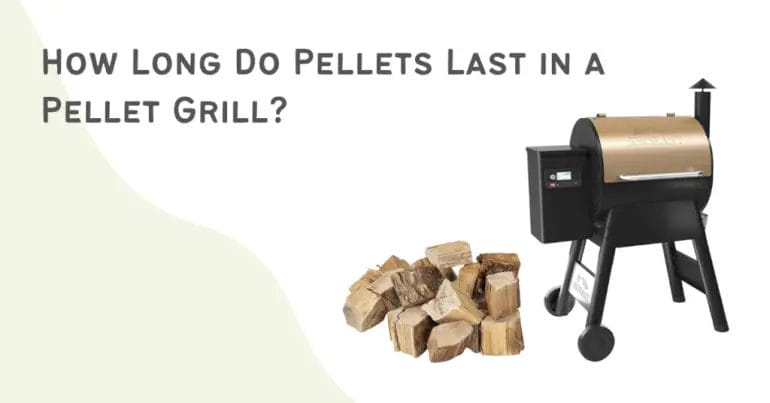Wood pellets are an eco-friendly and efficient fuel choice for heating systems, but how long do they actually last? The lifespan of wood pellets depends on various factors such as the size of the heating system and the temperature settings. On average, a 40-pound bag of wood pellets can provide heat for around 24 to 48 hours, depending on usage and temperature demands. However, it’s important to note that individual results may vary, so it’s advisable to consult the manufacturer’s guidelines for specific pellet usage and storage recommendations.

Factors Affecting Wood Pellet Durability
Wood pellets are a popular source of renewable energy, commonly used for heating and cooking purposes. The durability of wood pellets is an essential factor to consider when evaluating their quality and performance. It refers to the ability of the pellets to withstand handling, transportation, and storage without breaking or degrading.

Several factors can affect the durability of wood pellets. Understanding these factors is crucial for both manufacturers and consumers to ensure the production and consumption of high-quality pellets. Let’s explore some of the key factors that influence wood pellet durability:
1. Raw Material Composition
The composition of the raw materials used for pellet production plays a significant role in determining pellet durability. Wood pellets are typically made from various wood residues such as sawdust, wood chips, and bark. Different types of wood have different properties, including density, lignin content, and moisture content, which can impact pellet quality.
Hardwoods, such as oak or beech, generally produce more durable pellets compared to softwoods like pine or spruce. This is because hardwoods have higher lignin content, which acts as a natural binder and improves pellet integrity. Proper blending of different wood species can optimize pellet durability.
2. Moisture Content
The moisture content of the raw material is another critical factor affecting pellet durability. Excess moisture in the wood can lead to poor pellet formation and reduced durability. Moisture should be carefully controlled during the production process to achieve optimal pellet quality.
Typically, wood pellets are manufactured with a moisture content of around 6-8%. This level ensures that the pellets are hard and durable. Higher moisture levels can result in softer, less durable pellets that are prone to breaking during handling and storage.
3. Particle Size and Density
The particle size and density of the raw material impact the mechanical strength of the pellets. Finer particles tend to have better binding properties, resulting in stronger pellets. However, an excessive proportion of fine particles can lead to decreased pellet durability.
It is important to achieve the right balance between coarse and fine particles during the pelletization process. Additionally, proper compaction and densification of the raw material contribute to pellet durability. Higher pellet density translates to better resistance to external forces and improved durability.
4. Processing Parameters
The processing parameters during pellet production significantly influence pellet durability. These parameters include temperature, pressure, and residence time within the pellet mill. Each of these factors can affect the physical and chemical properties of the pellets.
Applying the correct processing conditions ensures optimal pellet formation and enhances their durability. This involves maintaining an appropriate die temperature, controlling the compression ratio, and adjusting the moisture content. Failure to adhere to these parameters may result in weaker pellets with reduced durability.
5. Handling and Storage
Even with well-manufactured, durable wood pellets, proper handling and storage practices are essential to maintain their integrity. Rough handling, excessive dropping, or exposure to moisture can all contribute to pellet breakage and degradation.
Wood pellets should be stored in a dry environment to prevent moisture absorption, which can weaken their structure. Using appropriate storage containers and handling equipment can also minimize the risk of damage during transportation and storage.
6. Quality Control Measures
Implementing robust quality control measures throughout the production process is crucial for ensuring wood pellet durability. Regular testing for parameters such as moisture content, pellet density, and mechanical strength helps to identify any deviations from the desired quality standards.
By closely monitoring the quality of the raw materials, production processes, and finished pellets, manufacturers can take corrective actions to optimize durability. This helps to maintain consistent pellet quality and ensure customer satisfaction.
Summary
Durability is a key characteristic of high-quality wood pellets. The factors influencing wood pellet durability include the composition of raw materials, moisture content, particle size, density, processing parameters, handling and storage practices, and quality control measures.
Manufacturers and consumers must consider these factors to ensure the production and use of durable wood pellets that provide efficient and reliable heating and cooking solutions. By understanding and addressing these factors, the wood pellet industry can continue to contribute to sustainable energy production.

Extending the Lifespan of Wood Pellets
Wood pellets are a popular source of renewable energy and are commonly used for heating and cooking purposes. However, one common issue faced by users is the degradation and reduced lifespan of wood pellets over time. In this section, we will explore various techniques and methods to extend the lifespan of wood pellets, ensuring their quality and effectiveness for a longer duration.
1. Proper Storage
One of the key factors in maintaining the lifespan of wood pellets is proper storage. It is important to store wood pellets in a dry and well-ventilated area to prevent moisture absorption. Moisture is the primary culprit behind the degradation of wood pellets, as it leads to the formation of clumps and mold. Storing wood pellets off the ground, on pallets or racks, can also help prevent moisture seepage from the floor.
Furthermore, it is recommended to keep the storage area away from direct sunlight, as prolonged exposure to UV rays can cause the pellets to break down and lose their integrity. Shielding the pellets from extreme temperature fluctuations is also crucial to prevent expansion and contraction, which can result in pellet disintegration.
2. Quality Assurance during Purchase
Choosing high-quality wood pellets during the purchasing process can significantly contribute to extending their lifespan. Look for wood pellets that have been certified by reputable organizations, ensuring that they meet industry standards. High-quality wood pellets are typically made from clean, dry wood without any additives, which enhances their durability and longevity.
Additionally, it is advisable to inspect the packaging for any signs of damage or moisture. Damaged packaging can allow air and moisture to penetrate the pellets, leading to their deterioration. Opt for sealed bags or containers to minimize the risk of contamination and to preserve the quality of the wood pellets.
3. Regular Maintenance of Pellet Stoves
If you are using a pellet stove for heating or cooking, regular maintenance is crucial to ensure optimal performance and prolong the lifespan of wood pellets. Cleaning the stove’s burn pot, ash traps, and exhaust system regularly prevents the accumulation of ash and residue, which can impede proper combustion and reduce the efficiency of the pellets.
It is also important to inspect and clean the stove’s auger, which feeds the pellets into the burn pot. A clogged or malfunctioning auger can disrupt the pellet flow, leading to incomplete combustion and increased pellet wastage. Regular maintenance, including lubricating moving parts and checking for any signs of wear and tear, will help ensure smooth operation and minimize pellet degradation.
4. Handling and Transport
Proper handling and transportation of wood pellets are essential to prevent damage and maintain their quality. When moving or transporting wood pellets, avoid dropping or throwing the bags, as the impact can cause pellet breakage and disintegration. Carefully stack and secure the bags to prevent shifting or crushing during transit.
It is advisable to use pallets or containers specifically designed for wood pellets during transportation. These containers provide added protection against moisture, dust, and physical damage.
5. Rotating Stock
To avoid the deterioration of wood pellets, it is recommended to practice stock rotation. By using the oldest pellets first and replenishing the stock with fresh ones, you ensure that the stored pellets are constantly being utilized and do not remain stagnant for extended periods. This rotation helps maintain the overall quality and reduces the risk of pellet degradation.
6. Consider Pellet Additives
In some cases, using pellet additives can help extend the lifespan of wood pellets. These additives are designed to enhance their durability, reduce moisture absorption, and prevent clumping. However, it is essential to carefully follow the manufacturer’s guidelines when using pellet additives to ensure their effectiveness and avoid any negative impact on the stove’s performance.
In summary, extending the lifespan of wood pellets requires proper storage, choosing high-quality pellets, regular maintenance of pellet stoves, careful handling and transport, stock rotation, and considering pellet additives. By implementing these measures, you can maximize the lifespan of wood pellets, ensuring their efficiency and effectiveness for a longer duration.

Storing Wood Pellets to Maximize Shelf Life
Wood pellets are a popular choice for heating homes and commercial buildings due to their renewable nature and efficient combustion. However, to ensure the longevity and quality of wood pellets, proper storage techniques are essential. In this section, we will discuss the key factors and best practices for storing wood pellets to maximize their shelf life.
1. Choose a Suitable Storage Location:
The first step in proper wood pellet storage is selecting an appropriate location. Ideally, the storage area should be dry, cool, and well-ventilated. Avoid areas with high humidity or direct sunlight, as these conditions can lead to pellet degradation and moisture absorption.
2. Use Airtight Containers or Bags:
Investing in airtight containers or bags is crucial for preventing moisture and air exposure. Pellets are highly sensitive to moisture, and even slight exposure can result in clumping, degradation, and reduced combustion efficiency. Ensure that the containers are made of durable materials that can withstand the weight and pressure of the pellets.
3. Keep Pellets Elevated:
When storing wood pellets, it is advisable to keep them elevated off the ground. This helps to prevent moisture absorption from the floor, especially in cases where the storage area is prone to dampness. Using pallets or stands can effectively keep the pellets off the ground and maintain their quality.
4. Maintain Consistent Temperature:
Wood pellets perform best when stored at a consistent temperature. Fluctuations in temperature can cause expansion and contraction of the pellets, leading to increased dust and reduced pellet integrity. Avoid storing pellets in areas that are subject to extreme temperature changes, such as near heating systems or vents.
5. Rotate Stock Regularly:
To ensure that stored wood pellets remain in optimal condition, it is recommended to rotate the stock regularly. Use the “first in, first out” approach to maintain freshness. By using older batches of pellets first, you can prevent prolonged storage and minimize the risk of pellet degradation.
6. Monitor Moisture Levels:
Moisture is the primary enemy when it comes to storing wood pellets. Regularly monitor the moisture levels in the storage area using a moisture meter or hygrometer. Aim for a moisture content of below 10% to maintain pellet quality. If moisture levels rise above this threshold, consider using dehumidifiers to control humidity.
7. Protect from Pests:
Pests such as rodents and insects can cause significant damage to stored wood pellets. Implement pest control measures to protect your pellets from infestation. Use pest-proof containers or bags, seal any entry points, and regularly inspect the storage area for signs of pest activity.
8. Consider Pellet Degradation Factors:
Various factors can contribute to pellet degradation over time. Exposure to sunlight, high humidity, and oxygen can all impact the quality and shelf life of wood pellets. By addressing these factors and following the recommended storage practices, you can minimize degradation and maximize the lifespan of your wood pellets.
In summary, proper storage plays a crucial role in maximizing the shelf life of wood pellets. By choosing a suitable location, using airtight containers, keeping the pellets elevated, maintaining consistent temperature, rotating stock, monitoring moisture levels, protecting from pests, and considering pellet degradation factors, you can ensure that your wood pellets remain in optimal condition for longer periods. Following these best practices will help you get the most out of your wood pellet investment and ensure efficient and reliable heating.Signs of Deteriorating Wood Pellets: When to Replace Them
Wood pellets are a popular choice for heating homes, as they are a cost-effective and eco-friendly fuel source. However, over time, wood pellets can deteriorate, affecting their efficiency and performance. It is important to recognize the signs of deteriorating wood pellets so that you know when it’s time to replace them. In this section, we will discuss the common signs that indicate the need for pellet replacement.
1. Increased Dust and Fines
One of the first signs that your wood pellets are deteriorating is an increase in the amount of dust and fines present in the bag or hopper. Dust and fines are small particles that are formed when the pellets break down. If you notice a significant amount of dust and fines when handling your pellets, it indicates that they are becoming brittle and breaking apart. This can lead to poor combustion and decreased heating efficiency.
2. Change in Color and Texture
Another sign of deteriorating wood pellets is a change in color and texture. Fresh wood pellets are typically light in color and have a smooth texture. However, as they deteriorate, the pellets may become darker in color and develop a rough or crumbly texture. This change in appearance indicates that the pellets are losing their integrity and may not burn as efficiently.
3. Increased Ash Buildup
If you notice an increase in the amount of ash generated when burning wood pellets, it may be a sign that they are deteriorating. When pellets break down, they produce more ash residue during combustion. Excessive ash buildup can lead to clogged vents and reduced heat output. Regularly inspecting your stove or boiler for ash buildup can help you determine if your wood pellets need to be replaced.
4. Poor Heat Output
Deteriorating wood pellets may also result in poor heat output. If you notice that your stove or boiler is not producing enough heat to effectively warm your home, it could be a sign that the pellets are no longer burning efficiently. In this case, replacing the wood pellets with fresh ones can help restore the desired heat output.
5. Unusual Odors
In some cases, deteriorating wood pellets may emit unusual odors when burned. If you notice a strong, unpleasant smell coming from your stove or boiler, it could be a sign that the pellets have degraded. These odors can be a result of moisture absorption or the breakdown of the pellets’ organic materials. Replacing the pellets can help eliminate these odors and ensure a clean and efficient burn.
In summary, recognizing the signs of deteriorating wood pellets is important for maintaining efficient and effective heating in your home. Increased dust and fines, change in color and texture, increased ash buildup, poor heat output, and unusual odors are all indicators that your wood pellets may need to be replaced. Regular inspection and maintenance of your pellet stove or boiler can help you identify these signs and take appropriate action to ensure optimal performance.
FAQs
How long do wood pellets last?
The duration of wood pellets depends on the usage and the size of the pellet stove or fireplace. On average, a 40-pound bag of wood pellets can last anywhere from 24 to 48 hours, providing consistent heat. Factors like the temperature setting and insulation of the space can also impact how long the pellets last.
Conclusion
In conclusion, the longevity of wood pellets depends on various factors such as storage conditions, usage, and quality. With proper storage in a dry and well-ventilated area, wood pellets can typically last for several years. However, it is recommended to use them within a year or two to ensure optimal performance. Regular maintenance of the pellet stove or boiler also plays a crucial role in extending the lifespan of the pellets. Moreover, investing in high-quality wood pellets ensures better efficiency and longer burn times. So, by following the necessary guidelines and using good quality wood pellets, you can enjoy a consistent and reliable source of heat for your home for an extended period.
Remember to consult the manufacturer’s recommendations and guidelines for the best practices to ensure the longevity of wood pellets.